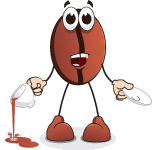|
A cup of coffee can help soften an acute attack of asthma. Africans used coffee as a kind of religious intoxicant when they first discovered it. A lifetime for the usual coffee tree is circa 50 to 70 years. Americans took a serious interest in coffee at the beginning of the 19th century due to the tea import being cut off because of the Civil War of 1812. Both French (1789–1799) and American Revolutions (1775-1783) were planned at coffee houses. Brazil is the world’s largest coffee producer. 44 millions of bags of coffee were produced in Brazil in 2006 where 27 millions of coffee bags were exported to the whole world. It cultivates over 4 million coffee trees which is an astonishing number.
Coffee gives bread and butter to more than 100 million people. Coffee houses in England blossom in 17th and 18th centuries as some special assembly places not only for educated and intelligent people but for regular men also. These were called “penny universities” as one penny was the price for a cup of coffee here. Coffee is the world’s second most consumed beverage after water.
In 1950’s a cup of coffee would cost circa 10 cents and even 5 cents in some places, even with a refill. The general locations for buying a cup of Joe were both a coffee shop and wayside snack bars. In December 2001 Brazil released a fragrant postage stamp to promote its coffee – the aroma is expected to last from 3 up to 5 years.
Satori Kato, a Japanese American chemist, is legally considered the father of the instant coffee which was invented in 1901. However its mass-production instant coffee owes to another chemist of English origin George Constant Washington which had place in 1906. The first coffee filter ever was created in 1908 by an ordinary German housewife from Dresden Melitta Bentz. The filter has been created from a blotting paper. Later the same year Melitta with her husband Hugo started their own business under her name. The Melitta trademark is associated with coffee filters till nowadays. There are 900 various Arabica flavors which are complex and volatile. However, if exposed to air and light, they will disintegrate.
Vincent Van Gogh was a big amateur of cafe society and has once pronounced a catch phrase: "I have tried to show the cafe as a place where one can go mad."
|
||||||||||||||||||||||||
Did you know?
Did you know?










